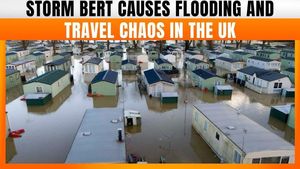A powerful volcanic eruption on Russia's Kamchatka Peninsula follows the tremors of a significant earthquake, sending authorities scrambling to mitigate potential risks. The eruption was triggered after a 7.0 magnitude earthquake struck the region, particularly affecting the city of Petropavlovsk-Kamchatsky on October 20, 2023, at 7:10 AM local time.
The earthquake was reported at a depth of 18 miles, causing considerable shaking throughout the area. Fortunately, there were no immediate reports of damage or injuries, and the tsunami warning associated with the quake was lifted shortly after.
Experts have raised alarms about the seismic activity, cautioning residents of possible aftershocks. According to Russian scientists, the tremors may signal the imminent danger of even stronger seismic events within the next 24 hours, possibly reaching magnitudes up to 9.0.
The Kamchatka Volcanic Eruption Response Team (KVERT) has issued aerial warnings as ash clouds spread across the atmosphere. Aircraft have been put on alert, receiving the highest “red” code due to the significant ash fallout.
Japan's Volcanic Ash Advisory Center (VAAC) has been closely monitoring the situation and confirmed continuing explosive activity from the volcano, which is known to arise with little notice. This kind of volcanic eruption, combined with seismic unrest, is not uncommon along the Ring of Fire, where tectonic plates frequently collide.
Kamchatka’s unique geography makes it home to multiple active volcanoes. The combination of tectonic plate activity and volcanic eruptions has been part of this region's natural history.
Residents are urged to remain vigilant as authorities assess the risks. The Institute of Volcanology noted their commitment to continuously monitor seismic activity, providing updates on potential changes and developments.
Communities near volcanic sites have been put on high alert as they gear up for any rapid changes. Public information campaigns aim to prepare residents, especially those situated closest to the volcanoes.
Local experts have been quick to point out the volatility of the region, which houses dozens of active volcanoes. These geological features regularly engage local scientists seeking to understand their patterns and potential hazards.
This eruption is part of Kamchatka’s storied volcanic legacy, where eruptions have shaped the land and impacted local ecosystems. The phenomenon showcases Earth's dynamic nature but also poses real dangers to nearby communities.
Volcanic ash can disrupt flight paths, contaminate water supplies, and cause respiratory problems for residents. Authorities are coordinating with health agencies to manage potential public health risks resulting from the ash fallout.
With residents keeping tabs on updates from local news and authorities, the sense of uncertainty hangs over the region. Community preparedness is emphasized as scientific agencies remain focused on predicting aftershocks and assessing volcanic impacts.
Officials continue to assess the integrity of infrastructures, especially near the epicenter of the earthquake. Their investigations aim to understand structural safety and prepare for any resulting evacuations if conditions worsen.
Given Kamchatka's natural beauty and stunning landscapes, it attracts tourism, which could suffer disruptions. Travel advisories remain active as visitors are cautioned about safety risks linked to seismic activities.
The region's isolation means local authorities are committed to ensuring thorough communication lines and quick response strategies. Emergency kits and alert systems have been emphasized within local initiatives.
Seismic experts from the Kamchatka Institute are expected to lead discussions on the geological impacts. Information dissemination remains key, ensuring all layers of the community understand what’s at stake.
This latest eruption and earthquake series come as reminders of the region's geological volatility, which has been studied for decades. Kamchatka's place along the Pacific Ring of Fire remains both fascinating and dangerous, leading to constant observation from worldwide scientists.
While the current situation poses distinct dangers, it is also ripe for academic exploration. Understanding the causes and effects of such seismic events ensures experts can provide actionable insights and aid future preparedness.
Air quality monitoring is now more critically assessed, particularly with ash clouds persisting. Scientists are predicting the ash may drift to other regions, potentially affecting air travel and local health.
Schools are implementing safety drills to prepare students for potential evacuations and precautions related to volcanic ash exposure. Community centers are also set up to act as shelters, should the need arise.
The geological significance of Kamchatka cannot be overstated as part of global volcanic research efforts. Events here connect to broader discussions on volcano monitoring, resilience, and community preparation.
Future assessments will be pivotal as scientists analyze data and local responses. This geological event serves as both warning and opportunity for increased awareness of seismic activities.
Residents remain hopeful, relying on their local governments and scientists to navigate these turbulent times. The community spirit, underscored by cooperation and preparation, is pivotal as they face potential aftershocks and volcanic unrest.
Concerns linger about the intersection of science and natural disaster responsiveness. Enhanced focus on training local responders is likely to accompany future geological studies.
The interplay between nature and community resilience is underscored by events like these, where scientific study plays as much of a role as actual geological occurrences. This delicate dance between preparedness and chaos is something residents of Kamchatka know all too well.



